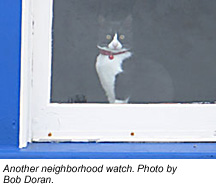|
COVER STORY | IN THE NEWS | FOOD | THE HUM | CALENDAR December 29, 2005
THE STOP AND SHOP MARKET'S THE KIND OF PLACE THAT pulls the neighborhood in on those languishing afternoons when eyelids droop and mouths salivate for something sweet, salty or laced with nicotine, and perhaps some liquid courage to wash it down. Crouched on the corner of Wabash and B streets in Eureka, it's a small, tidy, whitewashed structure with large windows and a glass door in constant swing as the people come and go. Outside, it's a typically gray winter day in Eureka; inside it's all clashing bright colors and tempting wrappers. On this particular Monday afternoon, the snackers, smokers and thirsty folk are popping in at a steady pace, milling about or making beelines to favored shelves and refrigerated cases, then hurrying their purchases to the counter. There, Jay Kang and his aunt Jenny Lee ring up the goods, reply to neighborly hellos, fetch cigarettes, supply lottery tickets and occasionally chat with each other in Korean. Lee, a tiny woman, is cheerful and efficient; she leaves frequently on errands. Her calm, tall young nephew offers nonchalant replies to customer's comments. Ask him about crime, though, and he's more talkative. "There's a lot of people here doing drugs," Kang says. "People come in here who are actually on drugs." He interrupts his tale to check out several customers: "A pack of Swishers," requests one guy. "What kind? Sweets? Optimo Mint? Peach?" asks Kang, reaching into the case on the counter. "Mint," says the guy. "I can actually pick out people who are carrying drugs," he continues. "And then there's pot, of course. One time, I had this guy, he walked in here with a handful of pot -- just loose, in his hand -- and he said, 'Can I have a bag?' I said, 'Here, take it.' I often find syringes dropped outside the door, or inside here. One time in the ice cream box I found a syringe." Kang figures the syringe fell out of a shirt pocket when someone leaned over to grab an ice cream. He also frequently finds tiny plastic jewelry baggies, containing powdered illicit drugs, on the floor. "I could find, like, one every day," he says. And there's vandalism: Two days ago, says Kang, someone slashed all four tires on his aunt's car. But he says it was worse before his aunt bought the place three years ago. "People were afraid to come in here. Isn't that right?" Kang asks a man buying an Oh Boy! Oberto pepperstick. "I've been coming in here since 1979,"
the man grumbles. His name is Troy Johnson. So what does Johnson
think of the neighborhood? "It sucks!" he says. He
was born and raised in Eureka, and he bought a house near Wabash
and A in 1979. Yes, Johnson says, nodding at Kang and his aunt,
"These are good folks, here." But the neighborhood
needs more law enforcement, he says. "The drug problems
have gone up, there's gang violence, our home has been tagged,
our vehicles have been broken into, our tires slashed. We call
this" -- he looks around the store -- "the 'Stop and
Rob.'"
Oh, but wait -- don't leave! It isn't that bad.
Or, maybe it is, here and there, but there's so much more to
the place. Even the "Stop and Rob" -- everybody calls
it that -- is loaded with quirky charm, compliments of the sarcasm-inclined
Kang. (More about that later.) Walk around the West Side a bit
(maybe not at night), stop for a chat (avoid the drug dealers)
and you might find it's the most interesting locale in Humboldt
County. Yes, it has its share of crime, and everybody agrees
there's a lot of drugs here. But it's also home to one of the
state's densest thickets of Victorians, Craftsman bungalows,
Vernacular-style early homes and other fine architectural relics
dating from 1849 on. Eureka's tourism bureau directs visitors
into the West Side to view the lovely old houses. And many of
these gems have been had for a song because they're so much cheaper
than their counterparts in most other old California cities.
At one point, Caltrans bought up a swathe of these paint-crumbling
but stalwart beauties and had plans to mow them under to make
way for a freeway bypass. Those plans fell through, and people
snapped up the bargain-rate "Caltrans houses." The West Side is bounded roughly by the curving Highway 101 corridor to the north and west, C Street to the east and Harris Avenue to the south. It's close to the Humboldt Bay waterfront and within easy walking distance of Old Town. It's the most multicultural spot in the county, according to U.S. Census maps (based on data from the 2000 census), with more than 20 percent of the population being non-white. Census Tract 1, which incorporates most of the West Side, and Census Tract 2, which incorporates the rest, had in 1999 the highest percentage of Hispanics, blacks and American Indians in the city. A large percentage of Asian Americans also live on the West Side. Indeed, says Kang, the West Side's more of a melting pot than Los Angeles, where he grew up (in Koreatown). Because Eureka's a small town, he says, people can't avoid each other -- and so they have to try to get along. "There's more diversity in L.A., but I see more of a fusion of the diversity in Eureka," he says. And he likes that. It's also true that poverty concentrates most heavily on Eureka's West Side, with nearly 30 percent of families living below the poverty level. Rentals proliferate: In 2000, in Census Tract 1, only 19.2 percent of the homes were owner-occupied. And the West Side, unlike most of the rest of the city, is zoned multi-family residential: In 2000, only 30 percent of the residential structures were single-family homes. Here, the city encourages high density and promotes low-income housing. Here, the city's housing element calls for phasing out single-family homes. The zoning, which dates to 1966, is reflected in Victorians being divvied into apartments, other historic homes being torn down to be replaced by newer multiplexes, and a plethora of halfway houses, transitional living centers, alcohol and drug rehab homes and other such arrangements that throw strangers together in the same residential building. There's even a pair of bed-and-breakfasts -- among the most elegant beasts in the neighborhood -- catty-corner to a threesome of rehab homes. It's certainly dynamic. But not everyone sees the mix as yielding a net positive. Some residents -- including a few new ones who've moved here to revel in that thicket of grand old homes -- mourn the loss of houses demolished. They worry about the crime they claim high-density and rentals foster. They disdain slumlords who don't keep up their properties. Their fretting is rising in volume. What's a city to do? On April 5, 2005, long-time Eureka resident Lorene
Dunaway, of B Street, wrote a letter dripping with displeasure:
"To the members of The Eureka City Council: It is with much
regret that I find myself writing a letter of opposition to the
members of this council. I am writing to protest the decision
to allow a new four-plex apartment unit which is under construction
at the corner of C and Washington. ... Does the City of Eureka
really want to diminish the attraction of this historic neighborhood?" Dunaway and others in the city's oldest neighborhood, anchored by Clark Street, have been trying for years to persuade the city council to establish the "Clark District" as an official historic district -- like Old Town, which has enjoyed a renaissance of appreciative restoration. Finally, this year, Councilmember Mary Beth Wolford -- whose district includes part of Old Town and the West Side -- launched some meetings. On Sept. 27, 110 people crowded into a room at City Hall. The mayor and council were there, as were the police chief, city attorney, district attorney, housing authority director, city manager and numerous residents who sometimes spoke in a high passion. "Slumlords are attracting crime," said one man, according to notes taken by the city clerk. Another man, Patrick Eytchison, said he lives two to three blocks from where police recently killed a man during a stand off. The pulp mill emissions that waft over from the Samoa Peninsula are a constant plague, he added. Joyce Hayes, executive director of the Humboldt Senior Resource Center in the historic old Washington School building on California Street, noted that there are transients, break-ins, abandoned vehicles taking up parking spaces and too many people racing their cars pell-mell down the street where elderly people are trying to cross. "It's the worst in six years," said a woman who lives on C Street. Someone else interjected, however, that she was "amazed by the dehumanization of poor people in this room." In the end, those gathered created three subcommittees -- on slumlords, Neighborhood Watch and zoning issues. At a meeting on Nov. 17 inside the Senior Resource Center -- behind which, in an apartment on W. Del Norte Street, there'd been a murder 10 days earlier -- they debriefed each other and said they had more work to do. The meeting wasn't nearly as well attended as the first one, but some of the main squeaky wheels were there, including West Side residents Ann White and Xandra Manns.
Immediately upon leaving her home's walkway on B Street, artist and neighborhood activist Ann White starts her narration -- an odd mix of delight, disgust and fear that would make the tourism bureau shudder. "This lady" -- she points at a pale blue house -- "she moved away because of the crime," says White. Passing by Jefferson Elementary School, she expresses dismay at a proposal to hold alternative high school classes here once the elementary school's closed because of low enrollment. Then she rants about the drug dealers. "They deal drugs right in front of the school. They'll have spotters down at those gray buildings, watching the street [for customers]. See where they're playing basketball? That's another ruse." She eyes some homely 1970s-built apartments, appalled.
Then a glorious old home. "See, I saw this," she says
excitedly, "and I fell in love with this area." She
grows somber: Here is a lovely, crumbling beauty in green, slipping
into decay, unprotected. "We lost three houses this year,"
White says. Then, glancing back down the block toward her home,
she spies someone walking by it. "Who's that down there?"
she asks, half-jokingly. "Get away from my house!"
she mutters, then half-laughs. At the corner of B and Simpson,
she notes an architectural mess: a Victorian that's been "modernized."
"It's called 'remuddled,'" she says. Then there are
the HUD apartments -- tidy enough, but not historic. "This
replaced an old Victorian," White bemoans. Walks on. Now here is a wonderful big old building. "That's the Launch Pad, for homeless kids. They're not supervised, they're always smoking and screwing in the back yard. And this woman" -- she points to another abode -- "oh, boy." Approaching another house she and her husband, Robert Serpa, bought to save from demolition (one of three in the neighborhood they own, including the one they live in) she says, "There were over 90 needles in it. The people who lived here were pooping in milk cartons and peeing in Budweiser bottles." The toilet, turns out, was useless because it hadn't been plumbed. It was just plunked onto solid floor. The Roto-Rooter man detected the oddity. White says, "The people making the decisions,
the city staff, they don't live here in this neighborhood."
Nor do the "hit-and-run" developers, as she calls them,
who she says get fee waivers and such to build low-income apartments.
"It's the density," she complains a few steps later.
"The city council -- the redevelopment board -- their plan
is to get rid of us homeowners." She wants the city to rezone
the area to encourage the preservation of the old single-family
homes and restrict further multifamily developments. She accuses
the city of "warehousing poor people" and wooing low-income,
services-dependent residents to Eureka by offering an easy dole
and housing. "At HSU they're training social workers, and
they think it's great to want to help these people. So they're
growing this industry, and they've created a needs community.
If I go ask for a permit for a home for unwed mothers and their
dogs, they'll fall all over themselves to help me. But if I say
I want a stop sign, they won't help." After attending an
October planning commission meeting, White says she concluded
that the city didn't want to spruce up the neighborhood because
that, in turn, might cause housing prices to appreciate and thereby
reduce the city's quota of affordable housing -- which in turn
could jeopardize its qualifying for certain grants. Back at her home -- a 1914 Queen Anne/Colonial Revival blend that she and her husband, also an artist, are renovating -- White says it had been a foster care home at some point, before they bought it. The house is in the once-swanky heart of the Clark District. White's house is a mix of historical correctness and Ann-specific whimsy. She and her husband stripped off the asbestos shingles to reveal the pretty siding and fish-scale pattern beneath and repainted. Inside, White's cheerful paintings -- fat hearts, letters, animals in bold color and form -- hangs in frames on the walls, and she's painted the lower halves of the dining room walls in red and white checkerboard. In the entryway lies a long canvas floor covering she painted. Strangely, in the dining room, where a huge wooden table resides, the wood floor is scattered with straw. White reveals that behind the closed bottom half of the door leading into the kitchen lurk her bunnies; the straw is for them, and just ends up working its way out into the rest of the house. On the table, she lays out two documents. One is "The Green Book," officially titled Eureka, An Architectural View, by the Eureka Heritage Society. It's a picture-laden survey of Eureka's architectural history, from the Gold Rush of 1849 to about 1970. At its end is a long list of buildings demolished and replaced by lesser structures. The second document is an inventory White made. She calls it, sarcastically, "Eureka, The Victorian Seaport. An Architectural View." It contains photos of the graceless replacements, mostly boxy, personality-poor apartment complexes with hideous metal railings. "They've just ruined the specialness of this place," she says.
Eureka Police Chief David Douglas had some good news for attendees at that November meeting: The department was seeking help from the California Highway Patrol to patrol the West Side. In addition, the city's contract with a private security firm to patrol Old Town would free up police officers to respond to more calls elsewhere. He also said the level of calls for service in Beat 2, which covers the southwest portion of the city from 14th Street south and east to A Street --a significant chunk of the West Side -- dropped in 2005, for the first time in 20 years (during which time calls for service all over the city have soared). Calls for service were highest in Beat 1, which covers Old Town and the waterfront as well as part of the West Side from 14th street north. As for types of crime reported, crimes against property were about double that of crimes against people. Later, in his office inside the police department headquarters at 604 C St., Douglas said crime in Eureka is mostly concentrated along the Highway 101 corridor, from the west all the way to the east. But he says, "drug issues have gone up in some neighborhoods" of the West Side. "And if we don't spend a lot of time there, the neighborhood will slide." Douglas says high-density living in Eureka isn't exactly a new thing: Even back in the 1800s people would build gigantic boarding houses that filled up with unrelated people. Still, he sees some correlation between high-density zoning and crime and dishevelment. Renters often don't feel "part" of the neighborhood, he says. And, "when you put more people in a tighter-packed setting, it means you get more 'rub issues.'" People get on each other's nerves. Smaller, cheap rentals have less storage space, so people end up storing things outside, which creates an eyesore. Their vehicles crowd at the curb. Also, with rentals "you get more flow of transients," says Douglas. "We have a lot of transient issues, and that's because of our mild climate, our high level of services -- [Eureka] is the only place for a long way around to get services." Some West Side residents have complained that the state is "dumping" its convicts off in Eureka. But a state parole department official said that state law requires that parolees, in general, be returned to the county of their last legal residence. According to the California Department of Corrections and Rehabilitation website, as of Nov. 30, 2005, 90 percent of parolees statewide were returned to the county of their last legal residence. The total population of parolees in Eureka as of that date was 794. The number of parolees in the West Side, says Douglas, is "highly disproportionate to elsewhere." That includes many of the city's registered sex offenders, according to the state's Megan's Law website. Douglas says the department does need more officers on patrol. It's eight officers short. "In the mid-90s, we were able to get some grants to do community policing," says Douglas. They had officers in the neighborhood, walking around. "The problems went way down." Then the grants dried up during a budget crisis, he says, and the department began to downsize.
Eureka Mayor Peter La Vallee just hates it when people blame social services and poor people for the city's problems. He happens to be director of the Redwood Community Action Agency's Youth Service Bureau, which operates a number of youth shelters and homes, including the Launch Pad on California Street, a licensed co-ed transitional living center for at-risk homeless teens. "I have a background in social services," he says. "I believe in social justice. So here I run this program that they think is part of the problem. But I think it's part of the solution." The kids La Vallee helps might, for example, have been living in an abusive situation at home, where drugs and violence were prevalent. Or they may have delinquent peers. "Look, we live in a culture, a society, where people have issues. And not everybody lives like 'Leave It To Beaver' or 'Father Knows Best.' I don't know how you can be so callous toward people with needs and problems." As for old houses, he has mixed feelings. "One they fought to save, right across from the Launch Pad, was torn down. But this old home was just falling apart. Pigeons were coming out of the roof. It looked like a good wind could have knocked it over. A fourplex went up, and I don't think it's so bad." "There is a legitimate argument that there's an over-concentration" of halfway houses and rehab homes in the West Side, he says. This doesn't necessarily mean the people in these places are nuisance neighbors -- even White doesn't think that. The trouble, often, is with negligent landlords who allow properties to decay and accumulate trash. "I would like to limit the number of [care] homes over there and start spreading it throughout the community," says La Vallee. But changing the West Side's zoning might present legal issues, he says. He thinks the solution lies within the neighborhood itself, in the people who already live there, and there's a specific program he'd like to introduce to the West Side: Asset-Based Community Development (ABCD), a concept conceived by John P. Kretzmann and John L. McKnight, researchers at Northwestern University. They describe ABCD as moving from viewing communities in terms of their problems, and instead looking at them in light of their assets: the people who live there, the neighborhood organizations, the official institutions. Once those assets are inventoried, they are brought together to strengthen the neighborhood. And the West Side, after even the most cursory of appraisals, seems to have assets in spades.
One of the best assets on the West Side is Xandra Manns. She worked as a planner for 20 years in the Bay Area. As a citizen, she fought to save old buildings. Her love of historic architecture was born in India where she also was born and raised. "In India they don't save buildings," she said. An exception was the boarding school in Kodaikanal where her missionary parents sent her from age 6 to 16. "The buildings were little stone bungalows, a hundred years old, with tile roofs and little wood stoves inside." When she retired, Manns searched around for a place
to live and fell in love with Eureka -- specifically the West
Side because of the historic houses. She moved here in 2002 and
bought a little Craftsman bungalow from the 1920s that was one
of a number of such homes the city had moved over from the Samoa
Peninsula. There's an alcohol rehab home two doors down from
h But she says she's given up trying to change the neighborhood's zoning -- it's too expensive. Instead, she's focusing on getting the historic district designation. And, in the meantime, she's gotten permission from the city and willing property owners (and raised $10,000) to plant sidewalk trees in front of houses and apartment complexes. Already it's made a difference in her C Street neighborhood, where since September slender magnolias and maples have been placed in newly cut squares in the sidewalks in front of many homes. Manns says she's gotten to know her neighbors in the process. She also dreams of a buffer zone -- along 8th Street, perhaps -- where the city could plant a long, green, park-like strip. She hopes to entice the city into such a project, which she thinks would make entering the West Side more of a neighborly pleasure. In fact, she says she'd like to map the whole city and find roads that could be blocked at one end and forced to turn, to slow down traffic and create spaces for small parks. But even if the city doesn't do anything, she thinks the neighborhood's going to change for the better. "People are buying old houses and fixing them up," she says. Just look at C Street: "This street is doing really well," she says, and even compliments HUD for keeping up its apartments. Manns says she doesn't think this change will necessarily result in gentrification in the negative sense of the word. "I hope it doesn't force low-income renters out of the West Side," she says. Maybe, she says, historic preservationists can take charge of fixing up old houses, then rent them out. Salaries and the market will determine rents, she says, adding however that she'd like to see rent control in the West Side. As for density, that doesn't bother her. "Density can be fun," she says, noting that rich New Yorkers seem to do OK with it. "It brings people out into the street."
Kevin Hamblin, Eureka's planning director, has a practical response for those who do malign the West Side's zoning. If not on the West Side, where, then, will low-income people live? According to Humboldt County Association of Realtors' figures on affordability from October, only 15 percent of Eureka residents could afford to buy a home. Though pitiful, that's higher than the countywide rate of 12 percent affordability. In addition, figures compiled by Community Legal Education show that a Humboldt County resident working for minimum wage -- $6.75 an hour in California -- would have to work 131 hours per week, 52 weeks per year, in order to afford a two-bedroom apartment at fair market rent (FMR). Viewed another way: To afford an FMR studio (no bedroom) apartment, a person would have to make at least $8.75 an hour at 40 hours a week. Besides, Hamblin says, even "if you change
the zoning today, all the existing uses stay there and they become
pre-existing non-conforming uses. A lot of people have said,
'I don't like the way things are now.' Well, we can't
change that." He agrees that there's an inordinate amount of transitional-type housing in the West Side. It comes with the territory of cheap houses and the right zoning. People in the halfway house or drug rehab business sometimes find they can make a tidy profit on the West Side. "They might get from $900 to $3,500 a bed, " he says. Such a facility can house six people without getting a permit on the West Side.
The door's still in motion; Kang's still ringing up customers. A young guy rolls his bicycle inside and props it carefully against a wall of goods near the entrance, eyeing Kang to see if he'll object, then browses around before bringing crackers and milk to the counter. Kang takes his money. The guy asks for a double bag, then wheels his bike back out. An older man walks in, using a cane, gathers a few items and steps up to check out. "If I don't see you, Kang, you have a nice Christmas," the man says. Another guy walks in, saying cheerily "Hey, hey, hey!" Kang, still telling crime stories, says when he finds drugs that have been dropped on the floor, he usually just flushes them down the toilet. And if he catches someone shoplifting, he'll rarely call the cops. "The police, they say, 'A $5 battery?!' They're not going to do anything about a $5 battery, or a Snickers bar." But Kang will call the cops for bigger occasions. "A few times I've seen people getting into fights," he says. "Like, one time there was a three-on-one, three guys beating up a young kid. Probably drugs. I called the cops." Another time, he says, somebody tried to walk off with the large tobacco case by the door. He called the cops. Two weeks ago, the store was burgled. He called the cops, and two brothers were later arrested in connection with that and other robberies. But Kang generally likes to deal personally with the light-fingered customers. His weapon? Mockery. After the store's security camera has captured them in the act, Kang enlarges the photos and prints them on plain white paper, writes caustic notes next to the images, and plasters them all over the store's walls. An alleged thief stares out from one flier, to which Kang has affixed an empty Trojans box. He's written next to that, "I stole CONDOM." In another set of photos, there's a man standing against the glass door entrance. Kang wrote this commentary: "Here is what happened. So, Jay comes down to the store at 3:15 a.m. and find this guy with his pants down against Stop N Shop door. Here is my question. 'Should he use condom?'" Fun stuff -- but Kang has found that mockery might also get results. He points out another of his fliers, in which a man clutches something in his hands. Kang's caption narrates the alleged robber's thoughts: "Jay found my 'Precious Ring' that I lost near the sidewalk. So, I told him to go fuck himself. I thank him so much for finding my grandmother's ring. In return I stole from his store. The CATFOOD. I'm so COOL." Kang says people came in and recognized that guy, and nobody's seen him since. Hmm. Maybe add Kang and the Stop and Shop to that list of community assets. COVER STORY | IN THE NEWS | FOOD | THE HUM | CALENDAR Comments? Write a letter! © Copyright 2005, North Coast Journal, Inc. |

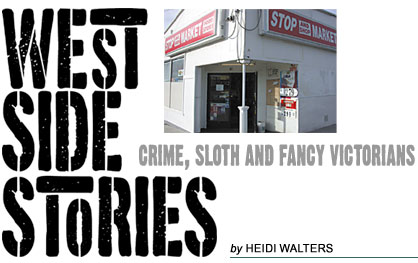
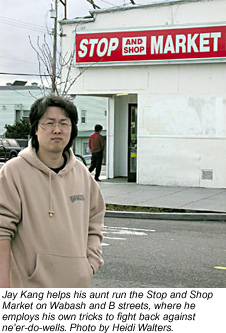
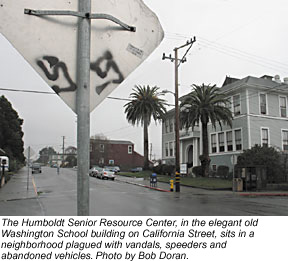
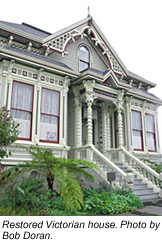
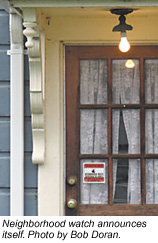
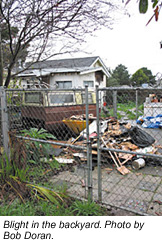
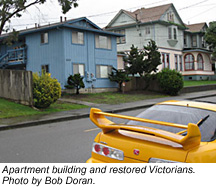

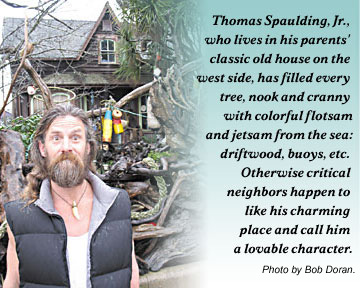
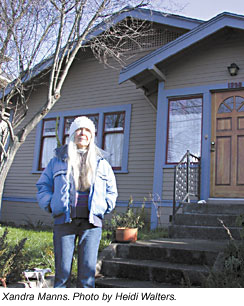 er
that she says "is run very well." Manns says she knew
the neighborhood was zoned multi-residential when she moved in,
but saw that as merely a challenge. "I just figure, no matter
where you live, there are going to be issues."
er
that she says "is run very well." Manns says she knew
the neighborhood was zoned multi-residential when she moved in,
but saw that as merely a challenge. "I just figure, no matter
where you live, there are going to be issues."